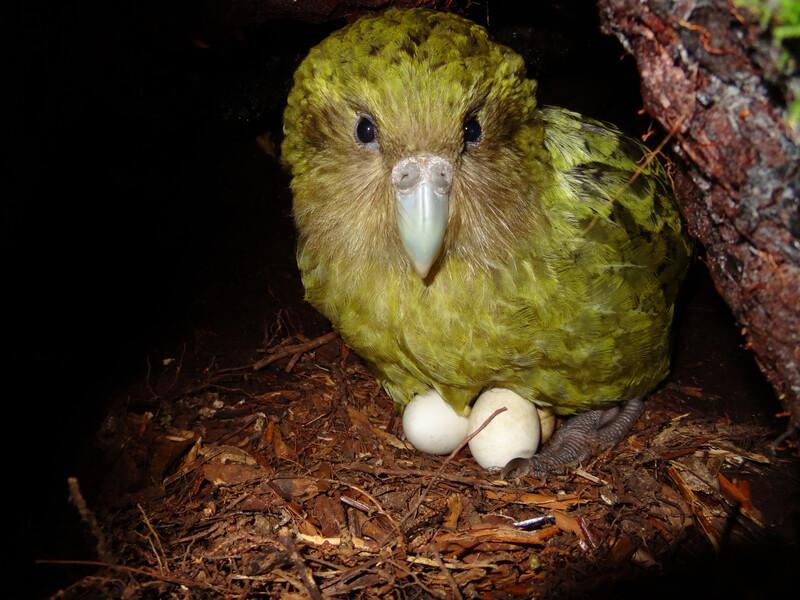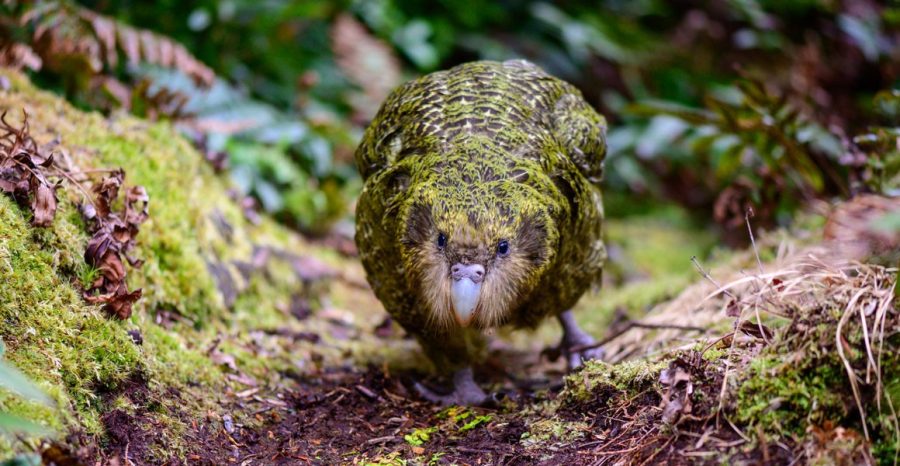The endangered ground dwelling creature
May 17, 2023
The Kākāpō is a nocturnal, ground dwelling, flightless native New Zealand bird. With a lifespan of 60 years and up, you may think this herbivorous bird looks abnormal compared to what common birds we know like the owl or parrot. The Kakapo is also known as the “owl parrot.” Its current population is 248, but this has not always been the case.
“When the first Polynesian sett lers arrived in New Zealand about 700 years ago, they found kākāpō to be easy prey. They ate its meat and used its feathers to make soft cloaks. With Polynesians came the Polynesian dog and rat, which also preyed on kākāpō” (www.doc.govt.nz). As time went on, the population declined even more because of forest clearance for farms and new species being introduced into its habitat. The population of this unique species grew near to being announced extinct after conservation efforts by Richard Henry had failed. “In 1894, the government launched its first attempt to save kākāpō. Pioneer conservationist Richard Henry led an effort to relocate several hundred of the birds to predator-free Resolution Island in Fiordland. The island didn’t remain predator free though – stoats arrived within six years, eventually destroying the kākāpō population” (www.doc.govt.nz). Soon, people had discovered that the Kakapo weren’t completely gone from the earth. “Kākāpō were once thought to be extinct until a population was found in the 1970s on Stewart Island, at the bottom of the country. They reached their lowest number in 1977 at just 18 known birds, and even by the mid-1990s the population had only reached 50” (www.theguardian.com).
lers arrived in New Zealand about 700 years ago, they found kākāpō to be easy prey. They ate its meat and used its feathers to make soft cloaks. With Polynesians came the Polynesian dog and rat, which also preyed on kākāpō” (www.doc.govt.nz). As time went on, the population declined even more because of forest clearance for farms and new species being introduced into its habitat. The population of this unique species grew near to being announced extinct after conservation efforts by Richard Henry had failed. “In 1894, the government launched its first attempt to save kākāpō. Pioneer conservationist Richard Henry led an effort to relocate several hundred of the birds to predator-free Resolution Island in Fiordland. The island didn’t remain predator free though – stoats arrived within six years, eventually destroying the kākāpō population” (www.doc.govt.nz). Soon, people had discovered that the Kakapo weren’t completely gone from the earth. “Kākāpō were once thought to be extinct until a population was found in the 1970s on Stewart Island, at the bottom of the country. They reached their lowest number in 1977 at just 18 known birds, and even by the mid-1990s the population had only reached 50” (www.theguardian.com).
One of the main problems with maintaining the Kākāpō population is lack of genetic diversity. This species suffers from inbreeding due to the lack of mates. Because the population is so limited, the genetic mutations accumulate and Kākāpō with two mutated copies of a particular gene will produce fewer offspring.
 This species “lek”breeds every two to four years in certain habitat conditions. “Kākāpō are long-lived and don’t start breeding until they’re about five years old. They only breed when rimu trees put out masses of fruit (rimu mast years)” (www.doc.govt.nz). “Lek” breeding is the process “in which two or more males of a species perform courtship displays. Lek behaviour, also called arena behaviour, is found in a number of insects, birds, and mammals. Varying degrees of interaction occur between the males, from virtually none to closely cooperative dancing”(www.britannica.com). “No other New Zealand bird does it, and no other parrot species in the world is known to lek breed” (www.doc.govt.nz).
This species “lek”breeds every two to four years in certain habitat conditions. “Kākāpō are long-lived and don’t start breeding until they’re about five years old. They only breed when rimu trees put out masses of fruit (rimu mast years)” (www.doc.govt.nz). “Lek” breeding is the process “in which two or more males of a species perform courtship displays. Lek behaviour, also called arena behaviour, is found in a number of insects, birds, and mammals. Varying degrees of interaction occur between the males, from virtually none to closely cooperative dancing”(www.britannica.com). “No other New Zealand bird does it, and no other parrot species in the world is known to lek breed” (www.doc.govt.nz).
 “Each kākāpō has its own personality. We get to know some birds well, such as the young chicks reared in captivity. They range from friendly to grumpy or just plain aloof. Some are cheeky and playful, some are explorers and several are insatiable food lovers” (www.doc.govt.nz). From personal experience since I own a parrot, this is entirely true. A bird can be loving and playful one day, but the next it would be grumpy and inactive. Personality among animals varies (especially pet owners know this).
“Each kākāpō has its own personality. We get to know some birds well, such as the young chicks reared in captivity. They range from friendly to grumpy or just plain aloof. Some are cheeky and playful, some are explorers and several are insatiable food lovers” (www.doc.govt.nz). From personal experience since I own a parrot, this is entirely true. A bird can be loving and playful one day, but the next it would be grumpy and inactive. Personality among animals varies (especially pet owners know this).
If you find the Kākāpō to be interesting you can find out more or donate to the conservation and recovery at www.doc.govt.nz/our-work/kakapo-recovery/.



